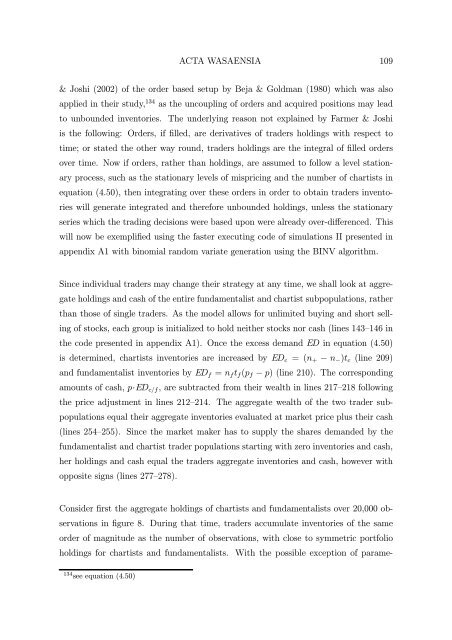BERND PAPE Asset Allocation, Multivariate Position Based Trading ...
BERND PAPE Asset Allocation, Multivariate Position Based Trading ...
BERND PAPE Asset Allocation, Multivariate Position Based Trading ...
Create successful ePaper yourself
Turn your PDF publications into a flip-book with our unique Google optimized e-Paper software.
ACTA WASAENSIA 109& Joshi (2002) of the order based setup by Beja & Goldman (1980) which was alsoapplied in their study, 134 as the uncoupling of orders and acquired positions may leadto unbounded inventories. The underlying reason not explained by Farmer & Joshiis the following: Orders, if filled, are derivatives of traders holdings with respect totime; or stated the other way round, traders holdings are the integral of filled ordersover time. Now if orders, rather than holdings, are assumed to follow a level stationaryprocess, such as the stationary levels of mispricing and the number of chartists inequation (4.50), then integrating over these orders in order to obtain traders inventorieswill generate integrated and therefore unbounded holdings, unless the stationaryseries which the trading decisions were based upon were already over-differenced. Thiswill now be exemplified using the faster executing code of simulations II presented inappendix A1 with binomial random variate generation using the BINV algorithm.Since individual traders may change their strategy at any time, we shall look at aggregateholdings and cash of the entire fundamentalist and chartist subpopulations, ratherthan those of single traders. As the model allows for unlimited buying and short sellingofstocks,eachgroupisinitializedtoholdneither stocks nor cash (lines 143—146 inthe code presented in appendix A1). Once the excess demand ED in equation (4.50)is determined, chartists inventories are increased by ED c =(n + − n − )t c (line 209)and fundamentalist inventories by ED f = n f t f (p f − p) (line 210). The correspondingamounts of cash, p·ED c/f , are subtracted from their wealth in lines 217—218 followingthe price adjustment in lines 212—214. The aggregate wealth of the two trader subpopulationsequal their aggregate inventories evaluated at market price plus their cash(lines 254—255). Since the market maker has to supply the shares demanded by thefundamentalist and chartist trader populations starting with zero inventories and cash,her holdings and cash equal the traders aggregate inventories and cash, however withopposite signs (lines 277—278).Consider first the aggregate holdings of chartists and fundamentalists over 20,000 observationsin figure 8. During that time, traders accumulate inventories of the sameorder of magnitude as the number of observations, with close to symmetric portfolioholdings for chartists and fundamentalists. With the possible exception of parame-134 see equation (4.50)
















